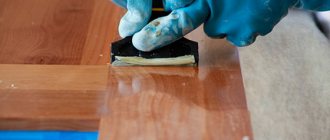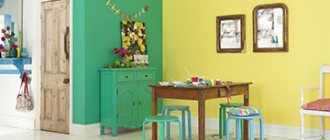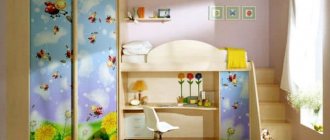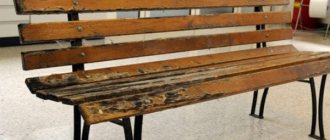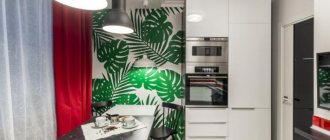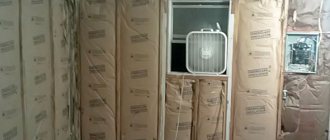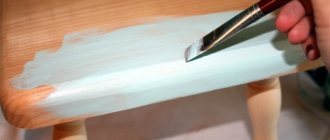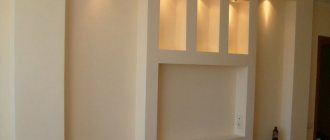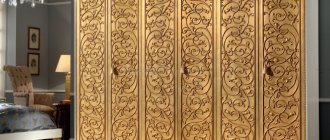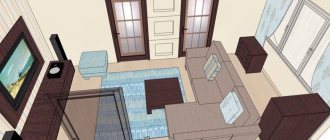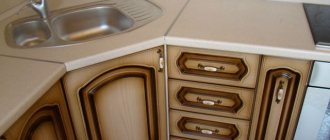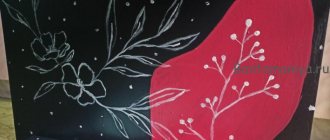Furniture made from chipboard and MDF has long become commonplace. New, easier to process and use, cheaper materials are actively replacing traditional products made from various tree species. And this is not surprising. The performance characteristics of high-quality artificial materials based on sawdust are in no way inferior to solid wood. And in a number of parameters they are even superior.
When choosing furniture for their home or apartment or organization, many buyers ask a logical question: how reliable and durable are these materials, and what are their differences. You often hear that DSAMP and MDF are practically the same thing, made according to common recipes, and there is no point in choosing. Is it so? In order not to make a mistake when choosing furniture, you need to clearly understand the differences between these two materials. What nuances need to be taken into account when purchasing furnishings for certain needs. Let's try to figure it out together with the experts.
What are the differences between laminated chipboard and MDF?
At first glance, indeed, furniture made from chipboard and MDF looks the same. The products look good, almost the same colors and textures are used. Even the shape and style of many models of kitchen, bedroom or living room sets are made according to the same design. Meanwhile, the difference between them is huge: in quality, in operating conditions, and even in price. All the differences are hidden in the depths, behind the attractive facades. They are associated with the peculiarities of production technologies for particle boards and finely dispersed fractions.
conclusions
MDF and chipboard are one group of materials, but different in properties and different in manufacturing methods. Professionals claim that MDF will very soon displace other materials that seek to replace natural wood. Since MDF is a natural, environmentally friendly and reliable material.
This means that it can be used to make cabinet furniture for both children and adults. Chipboard is an inexpensive, weaker material that some people consider toxic.
Disadvantages of laminated chipboard
- Due to the large number of large chips and heterogeneity of the structure, chipboards are prone to chipping of individual particles and the appearance of chips. Products can only be sawed in straight lines. They are not subject to fine milling or laser engraving. Therefore, it is very rare to find beautiful furniture facades made of chipboard, with figured cutouts, 3D relief images, and complex patterns. Mostly even, smooth doors are made from this material, suitable for modern styles.
- If water regularly gets into the joints and seams, the surface in these places swells and bulges into a hump. The product increases its volume up to 30%. The film begins to peel off. Inside the slab, the mass becomes loose, crumbles, and black mold appears. To avoid this, you should choose furniture with laser-cut edges (soldered joints). Such products are more durable. In addition, spilled liquids must be promptly removed by wiping the surface with a soft, clean cloth.
- Due to the low density of the base, the places where the fittings are attached gradually crumble. The fasteners begin to move freely in the socket. Furniture made from chipboard is not intended for frequent assembly and disassembly. It is enough to transport the set 1-2 times to a new place of residence, and it will warp in the most unimaginable way due to completely loose fastenings. To remedy the situation, you can use wood glue or use thicker screws. Or initially purchase products that use not ordinary fasteners, but bolts with wide washers.
- Low-grade types of chipboard negatively affect the health of children, adults, and pets. To produce the cheapest materials, large amounts of resins that emit formaldehyde are used. If new furniture has a specific, chemical smell, it is better to refuse the purchase. Living next to such a time bomb is simply dangerous.
Perhaps the most important disadvantage of laminated chipboard is its short service life. Such furniture lasts on average 5-7 years, subject to the rules of operation.
What is better for furniture
Before ordering kitchen furniture, countertops, chairs, etc., we all begin to think about what material they should be made of.
For us, the question becomes important regarding what will last longer, the features of the operation of the finished “product”.
It is worth noting that the wrong choice can not only affect the strength characteristics of the product, but also its appearance as a whole.
Tabletop
Countertops for kitchen units are usually made from laminated chipboards 38 mm thick. With the growth of the range of materials, recently, offers of 20, 28, 40, 50 and 60 mm are becoming more and more relevant.
Usually, as this value increases, the price of one m2 of the finished product also increases. A countertop made of artificial stone or acrylic will be much more reliable, durable and practical, but its price is several times higher than its counterparts made of chipboard.
Facades
Furniture facades can be made from both MDF and chipboard. In each specific case, the choice depends on where and under what conditions the furniture will be used.
Decor is also of considerable importance. Speaking about the kitchen and bathroom cabinets, then, naturally, you need to rely on moisture-resistant material. This can be a chipboard board, with special impregnation, or MDF. The ideal solution is an additional double-sided coating of facades with paint.
It is important to understand that the choice should not be based only on the type of material. The film adhesives used, if these are laminated surfaces, play a primary role in the durability of the finished product.
There are cases where facades made of chipboard lasted much longer and did not lose their appearance than similar elements made of MDF. A good solution is to choose plastic facades with a special acrylic coating applied to the surface.
Furniture cabinets
The most popular and profitable from the point of view of the price-quality parameter are chipboard enclosures. For the kitchen, laminated boards are most often chosen, with the most “affordable” decor, 16–18 mm thick.
If we are talking about more “solid” furniture, then it can use chipboard with a thickness of 22 or 25 mm. In some cases, for example, when it is necessary to make a non-standard tabletop, sidewall, wall or other part of the product, they resort to the method of screeding the material, which allows you to “type” a sheet of absolutely any parameters.
Advantages of MDF
- Since formaldehyde resins are not used in the production of MDF boards, they are much safer than chipboard. In fact, it is the same wood, with a small content of natural or urea resins, only more uniform and durable. The material is used in the manufacture of children's furniture, cribs and changing tables for newborns, products for children's and medical institutions. By purchasing furniture made from high-quality MDF, the buyer can be completely confident in its safety for health.
- MDF, even in its natural, uncovered form, is not afraid of water. Its dense structure simply does not allow liquids to be quickly absorbed, unlike some types of natural wood and, especially, chipboard. And an additional protective coating in the form of a laminating film or veneer gives it excellent moisture-resistant characteristics. Even many hours of exposure to puddles of water or other liquids are not dangerous for MDF surfaces. That is why furniture made from this material is recommended for “wet areas” - kitchens, bathrooms, swimming pools, toilets, dressing rooms.
- Dense sheets can be bent if necessary: they do not break or crack, and retain their shape perfectly. This feature is widely used in the manufacture of curved or concave facades and other elements.
- MDF sheets, thanks to their homogeneous structure, make it possible to produce richly decorated furniture facades. They perfectly withstand all types of processing: sawing, shape cutting, milling. The possibilities of milling this material are limited only by the designer’s imagination. Craftsmen form products with relief figures and designs, carve complex recesses and patterns, apply entire pictures to slabs, and make carved platbands and moldings.
- The edges and front part of the products have no joints or seams, as they are covered with one sheet of protective and decorative material. That is why products made from MDF successfully resist moisture and chemicals. The coating is so dense that it is very difficult to scratch or make a dent.
- You can spill water, caustic fruit acids, or soda solution on MDF countertops and kitchen aprons. If you wipe up the resulting puddle in a timely manner, there will be no consequences for the coating.
- Furniture made from MDF perfectly withstands repeated assembly and disassembly when moving and moving to other rooms. In this respect, it is comparable to products made from natural solid wood.
- Consumers are offered a huge number of finishing options: PVC film with the most fantastic shades and textures; glossy, mirror, matte and semi-matte coatings; products with metallic, mother-of-pearl effects, interspersed with sparkles and metal threads, patina; veneer from elite wood species; surfaces that perfectly imitate any type of wood, stone, textiles, leather. Even the most picky buyer will definitely find a product to his liking!
MDF or chipboard. What's best for children?
When choosing a children's room, we are, of course, concerned about the safety and environmental friendliness of future furniture.
Of course, a lot depends on the character of the child and the period for which you purchase furniture. For a long time or, for example, until the moment when the child goes to gnaw on the granite of science. If you have a hooligan boy growing up who conducts experiments on everything he sees, then MDF is your option. And if you have a gentle and neat excellent student growing up, then you may well make a choice in favor of chipboard.
Visit any of our Mr.Doors furniture showrooms with your children! We guarantee that you will experience a lot of positive emotions and get an answer to every question you have! You will be pleasantly pleased with professionalism, willingness to help, individual approach and high-quality service.
What are the disadvantages of MDF?
- Quite a high price compared to chipboard - 30-50% higher. High-quality MDF boards, coated with natural veneer, elite types of plastic or durable enamel, are close in cost to solid wood. However, they last two to three times longer than products made from chipboard or even solid wood.
- Plates consisting of small, homogeneous particles are prone to burning, even despite special impregnation with fire retardants.
- Dense material has more weight than particle boards, which affects the weight of the finished products. This must be taken into account when transporting and choosing an installation location.
To reduce the final cost of products and increase the number of sales, furniture manufacturers offer compromise options:
- cabinets for kitchens, living rooms, and bedrooms are made from straight, laconic chipboard plates;
- and beautifully decorated, carved facades are made from MDF.
Such furniture is affordable and lasts longer, thanks to durable, high-quality facades that take the brunt of the impact.
Differences
The two materials, which have been fighting each other for several years now, never stop competing. Despite the fact that MDF is rapidly gaining popularity, chipboard does not disappear from store shelves.
This is all because each type of plate has its own positive qualities. Professionals recommend choosing a material that will last a year and be safe.
And this suggests that you need to choose MDF. Another plus is that you can realize all your ideas. After all, this material is easy to cut and pleasant to work with.
This suggests that MDF can be used to make beautiful, luxurious furniture, which cannot be done from chipboard. But chipboard offers the consumer a reasonable price. Furniture production also involves combining materials.
For example, the frame can be made from chipboards, and MDF can be used as a frame facade. Since they try to make furniture beautiful, the material needs to be finished. The word finishing means carrying out simple manipulations with the application of an additional layer, such materials as laminate, veneer.
Veneer
It is difficult to cover chipboard with laminate or paper, this is due to the fact that the material itself already has bumps. And if a thin film is not glued to the surface of the slab, veins will be visible on it. First, the chipboard is veneered, and then the paper is applied.
Speaking about MDF, there are no questions in the area of its processing. It can be painted, covered with paper and laminate, and there will be no bumps. The reason for this is the initially dense material. What is chipboard and MDF in furniture?
These are the two main materials from which furniture is made, both for residential premises and for offices. Each of them has its own advantages and disadvantages. Before ordering a wardrobe or bed, decide what you expect from the design.
If your goal is to save money, then it is logical to choose chipboard, but if you are for reliability and durability, then MDF boards are waiting for you.
Of course, both materials have a presentable appearance, although luxury furniture is made from natural wood or MDF boards. Chipboard is not relevant in this case, since it is difficult to work with, especially when it comes to decor.
Is it possible to combine materials?
Often, in order to reduce the cost of products, manufacturers combine different materials. Basically, MDF is used to make cabinet doors, while chipboard is best suited for the frame. Nowadays, it is almost impossible to find such cabinets, the frame of which consists of finely divided material - the fact is that such structures will be too expensive.
Materials do not exclude the option of combining
Which material is suitable for kitchen furniture: comparison
To understand whether it is better to buy furniture made from laminated chipboard or MDF for the kitchen, you need to compare their positive and negative qualities.
Durability
Of course, when purchasing various pieces of furniture for the kitchen, we plan to use them for many years in a row, so it is necessary to choose the most durable material. As we mentioned above, low-quality furniture will quickly become unusable, and the kitchen will have to be replaced every two or three years, which is completely unprofitable.
MDF has better wear resistance
Furniture made from MDF is characterized by the highest durability (this feature is due to the almost natural composition of this material), and structures made from laminated chipboard will quickly lose their original appearance. If you provide good care for MDF furniture, it will definitely serve you for many years.
Resistance to various damages and negative impacts
Kitchen furniture must be resistant to various impacts and other damage. Of course, products made from MDF have better resistance to wear and oil stains. However, such a surface will suffer from constant exposure to steam or any liquid, and this will become noticeable within a few years. Furniture made from chipboard is less likely to deform under such conditions.
Laminated chipboard is stronger due to the synthetic resin in its composition
Otherwise, I would like to note that furniture deteriorates and breaks with equal frequency due to various mechanical damages, so it is difficult to select the best of the two materials. Note that laminated chipboard has a higher resistance to scratches, moreover, these surfaces can be washed without fear even with strong chemicals.
Environmental Safety
The content of toxic components in the composition negatively affects human health, so this point cannot be ignored. And since laminated chipboard still contains formaldehyde, albeit in small quantities (E1), purchasing such furniture is a risk, especially if kitchen furniture is made from it. Therefore, despite the large number of positive qualities, many refuse this lumber.
Chipboards may have a specific odor due to formaldehyde
Note! We should take a short digression to understand how synthetic resin affects health. This poison affects the nervous system, respiratory organs, liver, and kidneys. In addition, the substance irritates the mucous membranes of the eyes and provokes an allergic reaction.
The use of MDF in the kitchen, in turn, does not in any way affect people’s well-being, so if we evaluate materials on this point, then MDF is clearly the leader.
Aesthetic features
The attractive appearance of a kitchen is sometimes the main criterion by which it is chosen. Here, the two materials we are considering do not have any particular advantages over each other, since the modern furniture industry offers a lot of kitchen models made from both MDF and laminated chipboard. The choice is always a matter of taste, so for each buyer the conclusion about the external attractiveness of such furniture will be individual.
An example of an aesthetic kitchen made from chipboard
But, if you want to purchase a kitchen with various shaped elements, then of course you should choose MDF - laminated chipboard, due to its greater rigidity, is not suitable for the manufacture of such furniture elements. I would also like to note that laminated chipboard has a wide variety of shades, and if you are looking for furniture in bright or unusual colors, then you should take a closer look at this material.
